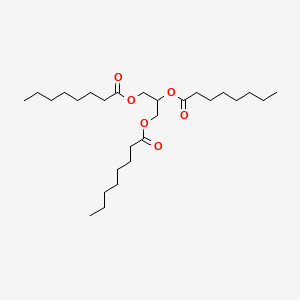



1. 2-ethylhexanoic Acid, 1,2,3-propanetriyl Ester
2. Glycerol Tricaprylate
3. Glycerol Trioctanoate
4. Glyceryl Tricaprylate
5. Glyceryl Trioctanoate
6. Octanoic Acid, 1,2,3- Propanetriyl Ester
7. Panasate 800
8. Triethylhexanoin
9. Trioctanoin
10. Trioctanoylglyceride
1. Trioctanoin
2. 538-23-8
3. Tricaprilin
4. Glycerol Trioctanoate
5. Glycerol Tricaprylate
6. Rato
7. Caprylin
8. Glyceryl Trioctanoate
9. Trioctanoylglycerol
10. Tricaprylic Glyceride
11. Maceight
12. Propane-1,2,3-triyl Trioctanoate
13. Glyceryl Tricaprylate
14. Caprylic Acid Triglyceride
15. Caprylic Triglyceride
16. Octanoin, Tri-
17. Axona
18. 1,2,3-tri-n-octanoylglycerol
19. Trioctanoin Oil
20. Octanoic Acid Triglyceride
21. Tricaprylyl Glycerin
22. 2,3-di(octanoyloxy)propyl Octanoate
23. Octanoic Acid, 1,2,3-propanetriyl Ester
24. Panacete 800
25. Glycerol Tri-n-octanoate
26. Miglyol 808
27. Nsc 4059
28. Tricapryloylglycerol
29. Tricaprylyl Glycerol
30. Glycerin Tricaprylate
31. Ac-1202
32. 1,2,3-propanetriol Trioctanoate
33. Cer-0001
34. Nsc-4059
35. Caprylic Acid, 1,2,3-propanetriyl Ester
36. Octanoic Acid, 1,1',1''-(1,2,3-propanetriyl) Ester
37. Trioctanoin;glyceryl Trioctanoate
38. Chebi:76978
39. Ac-1204
40. Ncgc00091285-01
41. Dsstox_cid_1375
42. Dsstox_rid_76119
43. Dsstox_gsid_21375
44. Tg(8:0/8:0/8:0)
45. Tricaprilin [jan]
46. 6p92858988
47. Sefsol 800
48. Caprylidene
49. Tri-n-octanoin
50. Trioctanoylglyceride
51. Cas-538-23-8
52. Einecs 208-686-5
53. 1,2,3-tricapryloylglycerol
54. Brn 1717202
55. Tricaprylm
56. Tri-octanoin
57. Tri-n-caprylin
58. Hsdb 7829
59. Emalex Ktg
60. Glycerol Trioctanoin
61. Mfcd00036236
62. Unii-6p92858988
63. Sefsol 810
64. Captex 8000
65. Axona [vandf]
66. Glycerol Trioctanoic Acid
67. Tricaprylin [ii]
68. Tricaprilin [inn]
69. Tricaprilin (jan/usan)
70. Tricaprilin [usan:jan]
71. Tricaprilin [hsdb]
72. Tricaprilin [usan]
73. Tricaprylin [inci]
74. 1,2,3-trioctanoylglycerol
75. Tricaprylin [mart.]
76. Schembl61958
77. Tricaprilin [who-dd]
78. 4-02-00-00991 (beilstein Handbook Reference)
79. Mls002454452
80. Glyceryl Trioctanoate, >=99%
81. Chembl1406148
82. Dtxsid6021375
83. Nsc4059
84. Propane-1,2,3-triyltrioctanoate
85. Glyceryl Tricaprylate [nf]
86. Hms3039h17
87. Hy-b1804
88. Zinc8214697
89. Tox21_111110
90. Tox21_201480
91. Tox21_302762
92. Caprylic Triglyceride [vandf]
93. S6342
94. Who 10584
95. Octanoic Acid,2,3-propanetriyl Ester
96. Akos015899778
97. Glyceryl Tricaprylate [usp-rs]
98. Tox21_111110_1
99. Ccg-214786
100. Db12176
101. 2,3-bis(octanoyloxy)propyl Octanoate #
102. Ncgc00091285-02
103. Ncgc00091285-03
104. Ncgc00256431-01
105. Ncgc00259031-01
106. As-75522
107. Smr001372028
108. Db-071745
109. Cs-0013846
110. Ft-0720359
111. T0365
112. D01587
113. Glyceryl Trioctanoate, Technical, >=90% (gc)
114. Sr-01000854712
115. Q2747851
116. Sr-01000854712-2
117. 3-(2-chlorophenyl)-1-(3,4-dichlorophenyl)-1-hydroxyurea
118. Tricaprylin, European Pharmacopoeia (ep) Reference Standard
| Molecular Weight | 470.7 g/mol |
|---|---|
| Molecular Formula | C27H50O6 |
| XLogP3 | 8.9 |
| Hydrogen Bond Donor Count | 0 |
| Hydrogen Bond Acceptor Count | 6 |
| Rotatable Bond Count | 26 |
| Exact Mass | 470.36073931 g/mol |
| Monoisotopic Mass | 470.36073931 g/mol |
| Topological Polar Surface Area | 78.9 Ų |
| Heavy Atom Count | 33 |
| Formal Charge | 0 |
| Complexity | 461 |
| Isotope Atom Count | 0 |
| Defined Atom Stereocenter Count | 0 |
| Undefined Atom Stereocenter Count | 0 |
| Defined Bond Stereocenter Count | 0 |
| Undefined Bond Stereocenter Count | 0 |
| Covalently Bonded Unit Count | 1 |
Excipients
Usually inert substances added to a prescription in order to provide suitable consistency to the dosage form. These include binders, matrix, base or diluent in pills, tablets, creams, salves, etc. (See all compounds classified as Excipients.)
In the small intestine, most triglycerides are split into monoglycerides, free fatty acids, and glycerol, which are absorbed by the intestinal mucosa. Within the epithelial cells, resynthesized triglycerides collect into globules along with cholesterol and phospholipids and are encased in a protein coat as chylomicrons. Chylomicrons are transported in the lymph to the thoracic duct and eventually to the venous system. The chylomicrons are removed from the blood as they pass through the capillaries of adipose tissue. Fat is stored in adipose cells until it is transported to other tissues as free fatty acids which are used for cellular energy or incorporated into cell membranes. When 14C-labeled long-chain triglycerides are administered intravenously, 25% to 30% of the radiolabel is found in the liver within 30 to 60 minutes, with less than 5% remaining after 24 hours. Lesser amounts of radiolabel are found in the spleen and lungs. After 24 hours, nearly 50% of the radiolabel has been expired in carbon dioxide, with 1% of the carbon label remaining in the brown fat. The concentration of radioactivity in the epididymal fat is less than half that of the brown fat.
Cosmetic Ingredient Review; Final Report of the Cosmetic Ingredient Review Expert Panel; Final Report on the Safety Assessment of Trilaurin, Triarachidin, Tribehenin, Tricaprin, Tricaprylin, Trierucin, Triheptanoin, Triheptylundecanoin, Triisononanoin, Triisopalmitin, Triisostearin, Trilinolein, Trimyristin, Trioctanoin, Triolein, Tripalmitin, Tripalmitolein, Triricinolein, Tristearin, Triundecanoin, Glyceryl Triacetyl Hydroxystearate, Glyceryl Triacetyl Ricinoleate, and Glyceryl Stearate; Scientific Regulatory Reference CD-ROM (2006). Cosmetic, Toiletry, and Fragrance Association, Washington D.C.
After absorption, long- chain saturated fatty acids are transported mainly via the intestinal lymph as triglycerides. Fatty acids with 10 or less carbon atoms are transported mainly from the intestine via the portal blood vessels. There are also data indicating that unsaturated long-chain fatty acids are absorbed mainly via the lymph vessels.
Cosmetic Ingredient Review; Final Report of the Cosmetic Ingredient Review Expert Panel; Final Report on the Safety Assessment of Trilaurin, Triarachidin, Tribehenin, Tricaprin, Tricaprylin, Trierucin, Triheptanoin, Triheptylundecanoin, Triisononanoin, Triisopalmitin, Triisostearin, Trilinolein, Trimyristin, Trioctanoin, Triolein, Tripalmitin, Tripalmitolein, Triricinolein, Tristearin, Triundecanoin, Glyceryl Triacetyl Hydroxystearate, Glyceryl Triacetyl Ricinoleate, and Glyceryl Stearate; Scientific Regulatory Reference CD-ROM (2006). Cosmetic, Toiletry, and Fragrance Association, Washington D.C.
The skin penetration enhancement of drugs by tricaprylin has been demonstrated in vivo using Wistar rats and in vitro using hairless female mice. ... The drug permeation ratio in the presence of triglycerides increased in the following order: Tricaprylin (C8) > Triolein (CI8) > Tributyrin (C4) > Triacetin (C2).
Cosmetic Ingredient Review; Final Report of the Cosmetic Ingredient Review Expert Panel; Final Report on the Safety Assessment of Trilaurin, Triarachidin, Tribehenin, Tricaprin, Tricaprylin, Trierucin, Triheptanoin, Triheptylundecanoin, Triisononanoin, Triisopalmitin, Triisostearin, Trilinolein, Trimyristin, Trioctanoin, Triolein, Tripalmitin, Tripalmitolein, Triricinolein, Tristearin, Triundecanoin, Glyceryl Triacetyl Hydroxystearate, Glyceryl Triacetyl Ricinoleate, and Glyceryl Stearate; Scientific Regulatory Reference CD-ROM (2006). Cosmetic, Toiletry, and Fragrance Association, Washington D.C.